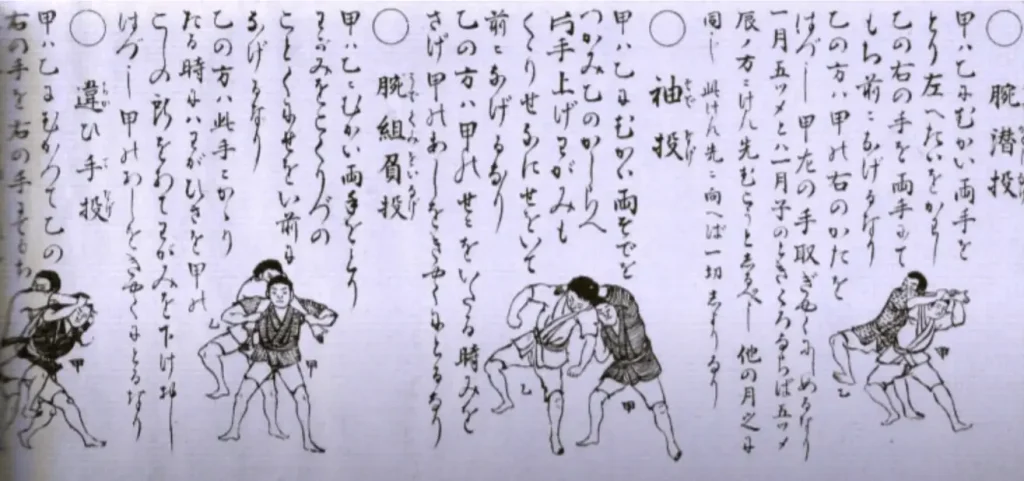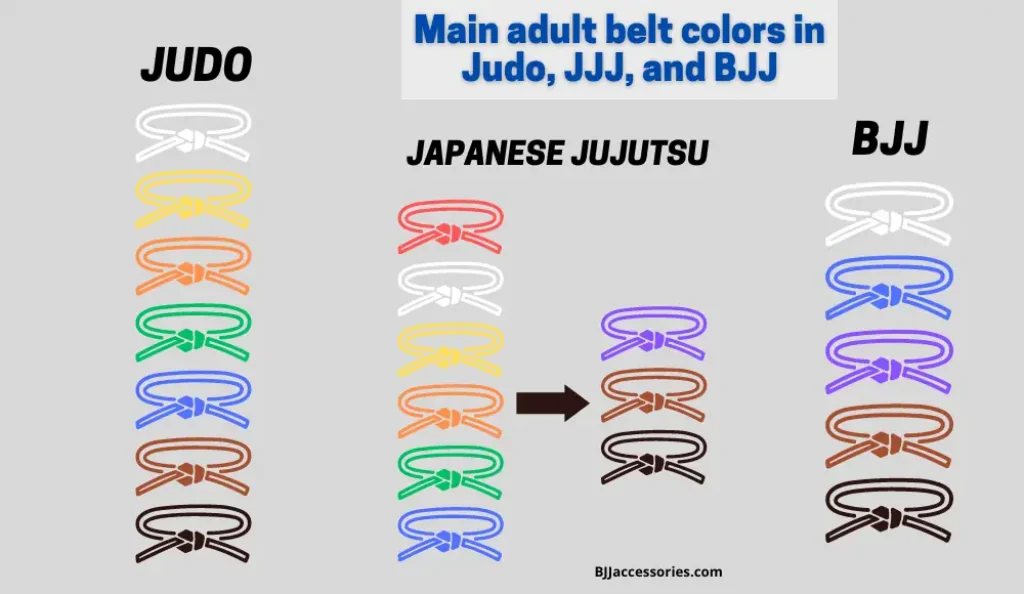Japanese jiu jitsu vs Judo Difference [Explained]
The Japanese jiu jitsu vs judo comparison is the same as the opposing of Brazilian jiu jitsu vs judo and all of them together with each other.
And it’s no wonder.
Japanese Jiu Jitsu, Judo, and BJJ are so closely interconnected with their historical roots that such discussions will continue constantly. Even despite the fact that all three martial arts today are very different combat styles, especially in the field of modern competition rulesets.
Anyway, the constant and regular discussion of this topic is only an advantage as it keeps the historical aspect of martial arts on the surface.
What are the Japanese jujutsu martial arts?
Jiu jitsu, jujitsu, or jujutsu martial arts is a collective name of a Japanese martial arts family.
Jujutsu from Japanese literally means “soft skills”. But don’t let it delude you. Initially, Jujutsu was created centuries ago as a defensive close-contact combat style on battlefields with or without weapons.
What is jujutsu vs jiu-jitsu?
So, is it jiu jitsu or jujutsu? Why are there different names and what is the difference?
The difference between jiu jitsu, jujitsu, and jujutsu names is in the spelling and transliteration ways from Japanese to Western languages. So, there is no difference between jujutsu vs jujitsu vs jiu-jitsu, or jujitsu.
All these are the same names for Japanese jiu-jitsu which is mainly called jujutsu in English as a standard spelling.
Is judo similar to jujitsu?

Yes, judo techniques principles are similar to jujitsu (jujutsu). Both styles utilize techniques such as throws, joint locks, and grips. Both are close-contact martial arts and both are standing fighting styles.
But nevertheless, they have differences, as jujutsu may have also striking techniques in its arsenal that are not allowed in judo. What’s more, many old Japanese jujutsu techniques are banned in modern judo because they are considered dangerous and deadly.
Also, some jujutsu styles practice fighting techniques with weapons.
Another common thing between judo and jujutsu is their origin.
Despite the worldwide spread of judo and the various styles of traditional Japanese jujitsu, they remain Japanese. At the same time, Brazilian jiu jitsu is an example of how a martial art can transform from one into another martial art style stepping on a new own way but still preserving some traditions.
Is judo a form of jujutsu?
For those who are in martial arts for a while already the question regarding who was first – Japanese jujutsu or judo – is on the surface.
Before judo only started, jujutsu already existed for centuries presented by many different schools.
Japanese jiu jitsu vs judo difference is easier to understand if you know the origins of them. Here is a simple visualization of it in a form of a lineage:
*But keep in mind, all these three styles exist independently. It’s just a way to show the historical track.
Japanese jujutsu => Judo => Brazilian jiu jitsu
Jujutsu is the ancient parent style for judo, aikido, Brazilian jiu jitsu, and all other modern grappling styles that were influenced by or directly followed Japanese jujutsu fighting art.
Judo and Japanese jiu-jitsu techniques names
Obviously that the Japanese judo technique names come from jujutsu on a consequential basis. Another obvious fact for it is that the techniques terms are mostly descriptive names in Japanese.
For instance, the Kotegaeshi wrist throw in Japanese is 小手返 and is worldly translated as “little hand return” or “forearm return”.
The jujitsu and judo Japanese words for naming the techniques intersect with each other. No wonder, as judo techniques find their root in jujutsu. The same name of Japanese jiu-jitsu throws you can find also in aikido.
Kotegaeshi wrist throw technique
Kotegaeshi is a popular wrist throwing technique in Japanese jiujitsu and aikido.
Japanese jiu jitsu belts system
Are there belts in Japanese jiu-jitsu?
Yes.
But, there is one interesting detail.
Japanese jujutsu as the root style for judo and BJJ didn’t have belt progress levels at all. The colored belt ranking system was created and implemented by Jigoro Kano – the founder of judo.
Obviously, BJJ has followed the belt levels system right away from its start but with its own changes.
Over time, a Japanese jiu jitsu belts order came into the gameplay as well. It would be surprising if not. Nowadays, belt systems in martial arts are a convenient method of regulation and marking the progression timeline of martial artists. Also, belt differentiation is the key point in tournament regulations.

Japanese jiu jitsu belt system is very similar to the judo belt order but with its own changes to it. Each jujutsu school may have its differences in belt ranking system and grades.
Judo, JJJ, and BJJ have different from each other belt requirements.
How long does it take to get a black belt in JJJ?
Each martial art has its own requirements to get a black belt. Here you can read about the judo black belt requirements and here about how long to get a black belt in BJJ. If you want to compare other black belt requirements, you can find out more about taekwondo black belts here.
The time frame from a beginner to a black belt in JJJ (Japanese ju jutsu) varies depending on the style and dojo. For instance, in some traditional Japanese Koryu styles a time frame to shodan (1st black belt grade) of at least two years is required. The average time frame overall is about five years.
Japanese Ju Jutsu black belt exam
Is judo better than Japanese Jiu-Jitsu?
Is judo more effective than Jiu-Jitsu? In other words, is judo better than Japanese jiu-jitsu?
First of all, better for what? And secondly, how much objectivity are you ready to involve in the pros and cons of research?
Different martial art styles are different because they have different applied meanings.
If your case is to choose between judo or JJJ for specific training goals, the pros and cons scenario is a good option to make a decision. Because talking generally about what is better judo or jujitsu is pulling yourself into an endless dispute. Especially if there is more than one of you.
Below we give a table with some short points of view related to judo and jujutsu training flow. This should help guide and ease your decision on whether to pursue Judo or JJJ.
| If choosing JJJ ask the dojo if they have regular sparring sessions in case you want to have some practical skills for self-defense situations. In this case, judo by default has sparring practice. |
| Judo is an Olympic sport. In some countries, there is subsidized funding for judo classes. |
| There are fewer judo classes for adults than it is in BJJ. The older you get in judo, the fewer partners your age you meet. Whereas in JJJ it is common to practice at any age to due diverse jujutsu styles. |
| Judo has more sports intent while JJJ is often about practicing the fighting techniques of a specific jujutsu style. |
| Both, Judo and JJJ, have a minimum of ground fighting. But in judo, there is the Kosen ne-weza competition style. |
| Before choosing a JJJ dojo one should do research first regarding what style of JJJ they present if any. There are situations when a JJJ school doesn’t belong to any traditional jujutsu style and train some mixed arts of JJJ and karate, for example. |
If you want real sparring jujutsu, pay attention to the German Ju Jutsu. Worth mentioning that German Ju Jutsu is not a pure JJJ style and was developed in the 60s on the basis of Japanese martial arts Including JJJ.
German Ju-Jutsu Open 2019